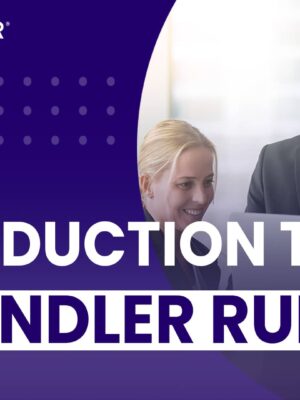Sales Leaders: Improve Forecast Accuracy and Closing Ratios… by Aligning Your Sales Process, and Your Debrief With the Buyer Journey

We’ve all been in situations where a salesperson says, “I’ve got X amount of revenue coming in this month”… and reports a couple of weeks later that everything is “still on track” for hitting the revenue target of X… but then, at the end of the month, tells us that the actual figure is X minus Y, totaling Z. Where Z is a number smaller than we were promised- or expected to hear.
This dynamic plays out all the time, in virtually every industry we serve. In fact, we’ve noticed it happens often enough that seasoned sales leaders eventually learn that this phenomenon is something that needs to be planned for and taken into account.
The problem is, though, that what sales leaders typically do in response to this challenge is the same thing that salespeople do to create the challenge in the first place.
Hear me out. Salespeople sometimes operate by gut, and they often don’t even realize they have less information than they need to be able to make an accurate prediction about the viability of an opportunity. So when it’s time to make projections, they throw out a number anyway. They do this with optimism, confidence, and authority — because hey, optimism, confidence, and authority are their self-protection tools in the brutal world of sales.
Then what happens? A little time goes by; they realize they’re missing some critical piece of information and maybe need some help… but they hesitate to say that to their manager, because they already stated, with optimism, confidence, and authority, that they’re going to hit the target of X this month. So they say nothing (and try to fix things) until the last possible minute. That’s a classic low-information, low-communication cycle.
But here’s the irony: Too many sales leaders operate by gut, as well.
They say to themselves, “Okay — Jim is likely to exaggerate – I’ll cut his forecast by 50%. Maria is less likely to exaggerate, I’ll cut her forecast by just 15%. And Tim, I can count on him, but who knows, he might hit a bump in the road. I’ll cut his forecast by 5%. That way, when I add everything together, I should get a number that’s relatively accurate.”
Reality check: If both sides are operating by gut, if both the salesperson and the sales leader are using instinct instead of quantifying what’s in front of them, that makes the low-information, low-communication cycle even worse… and the team’s results suffer.
Let’s face it: This deepening low-information cycle doesn’t help the person-to-person relationship between the seller and the sales leader; It stresses everyone. More to the point, it delivers forecasting results that are unreliable and unpredictable. And when it comes to revenue production, reliability and predictability are supposed to be the name of the game. So: what’s the solution?
At Sandler, we say the solution starts with a question: Whose job is it to qualify leads?
Most people we talk to say, “That’s the salesperson’s job.” And of course, from a formal point of view, that’s correct. Yet, at the same time, it’s the sales leader’s job to set the benchmarks for qualification – to clearly define what is and isn’t a qualified opportunity. In other words, the quality of the revenue forecast depends on the quality of the pipeline debrief led by the sales leader.
Leading a better qualification debrief begins with leading a better discussion about the various benchmarks in the sales cycle. And a very dysfunctional, very common, very low-information forecast cycle that we’ve been talking about is, at its core, a problem arising from ambiguity among team members about the benchmarks that define a qualified opportunity at any given stage of our sales process. If that definition is unclear, pipeline hygiene will suffer, closing rates will not be optimal, forecasts will be unreliable, and our teams will flounder.
Sad but true: All too often, our sales teams do flounder.
Why? One big reason is that there is no clear understanding of the multiple criteria that determine what constitutes a qualified lead at any given stage… and no clear understanding of what is needed to move an opportunity to the next stage.
And here’s the point sales leaders often overlook: We need those criteria not just at the beginning of the discussion with a prospective buyer, but at all the various points at which buyers are likely to interact with the sales team. When those criteria are vaguely defined, or missing altogether, that is a sales leadership challenge — not a salesperson’s performance challenge.
Peter Drucker once observed: “If you can’t measure it, you can’t manage it.” Yet, in our experience, many sales leaders completely miss the opportunity to objectively and comprehensively track, measure, and quantify the progression of their team’s sales opportunities. What may make monitoring this progression a bit of a challenge is that it takes place in two dimensions at once.
In any given sale, there is the buyer’s progression through the buying journey – and there is that same opportunity’s parallel progression through the organization’s sales process.
These two journeys dovetail, of course, and ideally, we want them to inform and reflect each other. They’re two sides of the same coin… and just as there’s no such thing as a one-sided coin, there’s no such thing as a sale that unfolds in only one of these dimensions! This is one of the reasons we must be willing to critically examine what’s happening to every opportunity, at every key point in its progression, with an eye toward process and measurable outcomes – as opposed to the salesperson’s “gut feeling” about the likelihood of closure.
The best way for leaders of sales teams to make that critical assessment is through an ongoing series of conversations with the members of the sales team: qualification debriefs.
Learning to lead these debriefs well is essential to the mission of leading a sales team that adopts the cultural focus of a) putting buyers first and b) proceeding from data, rather than emotion, in critical business decisions.
A good qualification debrief does not ask questions like “What’s your feeling about whether this is going to close?”. Instead, this debrief includes questions about specific, relevant benchmarks in the team’s documented sales process.
Here are some ideas that can help you make qualification debriefs more productive – make that data-driven, buyer-first cultural focus a daily reality for your team – and make tracking, measuring, and quantifying specific business-to-business revenue opportunities easier and more accurate.
Understand the Buyer Journey
We believe the best approach for all sales leaders, regardless of the industry the size of the team they lead, is to assume the buyer journey has changed since they last checked it.
In fact, the odds are quite good that it has changed. If you haven’t checked your ideal customer’s buyer journey lately – as in within the last sixty days — your best working assumption should probably be that you now do not understand that journey. That’s a problem, because if your sales process doesn’t map your buyer journey, you’ve lost ground to competitors who do map their sales process to that journey.
In today’s world, doesn’t it make sense to assume that buyers are more educated than they were yesterday?
There may now be more or different decision-makers and/or influencers involved in a given purchase, all of whom have access to massive amounts of information; strategies in buying may have shifted; and people at all levels of the buying organization may have begun taking advantage of a dizzying array of communication platforms, some of which they weren’t using yesterday.
The technology has changed and is changing… the way we interact with our customers has changed and is changing… and social and cultural norms affected by developments in fields like artificial intelligence will continue to dramatically change the selling landscape. All of these facts are compelling reasons to look closely at your buyer’s journey, and find out what types of questions your buyer is asking, so you can map your team’s sales process to those questions.
Of course, I don’t know what your ideal buyer’s journey looks like… but I do know it is very likely to break down along the following lines:
- Awareness
- Engagement
- Consideration
- Decision
- Advocacy
These stages are broken down in detail below.
Map Your Sales Process and Your Qualification Debrief to the Awareness Stage of the Buyer Journey
Let’s look now at each of the main stages of the buyer journey, so we can consider how a hypothetical sales process might be mapped to it. Obviously, you would want to create a specific map based on your organization’s product/service and your team’s selling environment, but the fictional sales process I’m about to outline will give you a sense of the kind of issues you will want to cover during your qualification debrief sessions with your team.
STAGE ONE: AWARENESS
The impact of a problem you and your organization can solve is felt, but no action is taken. In many cases, the problem is misdiagnosed.
We can expect prospective buyers in this stage to ask themselves and their allies:
- What’s the deal with so-and-so? (Where “so-and-so” may be the symptom, not the cause.)
When the buying organization is in the Awareness stage… it makes sense to map out our sales process activities for getting on the radar screen of prospective buyers and influencers. Activities that accomplish this goal, and their outcomes, are what we want to track during this part of the buyer journey. As sales leaders, we should be asking ourselves these questions:
- What specific, countable behaviors support the goal of positioning our organization, and the individual salesperson, as resources, as deployers of expertise, as solvers of the problems likely to be impacting the buyer’s world?
- How will the members of our team evaluate the effectiveness of those behaviors? What online platforms will come into play? And how?
- What real-world events could we host or be part of that would place us and organization on the radar screen?
- What resources do we offer or could we offer that would place us and our organization on the radar screen?
- And here’s the big one: What, specifically, needs to happen for us to be certain that the buyer has moved out of Awareness and into Engagement?
For instance: The buyer schedules a discovery meeting with us.
Notice that, in this example, the buyer scheduling a discovery meeting with us is an EXIT CRITERION. If that discovery meeting hasn’t happened, we don’t move the opportunity forward in the sales funnel. It can’t move into the realm of discussions from which we are projecting income. It’s not an active opportunity.
It’s the sales leader’s job to make sure the right exit criteria are identified, clearly documented, regularly discussed, and consistently followed! A critical qualification debrief question within this hypothetical sales process, therefore, is going to be:
- Has the buyer scheduled a discovery meeting?
Map Your Sales Process and Your Qualification Debrief to the Engagement Stage of the Buyer Journey
Back to our hypothetical sales process. If all goes well, and the right exit criteria are fulfilled, the opportunity moves forward into the next stage, namely…
STAGE TWO: ENGAGEMENT
Buyers and influencers begin internal discussions about what they think they need to do to solve the problem and minimize its negative impact on the organization. Here, again, the problem may or may not be accurately defined.
We can expect prospective buyers in this stage to ask themselves and their allies:
- Is there really a problem?
- If there is a problem, who is it affecting and how?
- If there is a problem, what might be the right response?
- What happens if we do nothing?
When the buying organization is in the Engagement stage of the buyer journey… it makes sense to map out and track our sales process activities for getting and staying on the calendar. Accordingly, we should be asking ourselves these questions:
- What specific, countable behaviors support the goal of scheduling and leading real-time discovery meetings with decision-makers, influencers, and stakeholders within the buying organization?
- How will we evaluate the effectiveness of those behaviors?
- What is the scheduled next step with the buying organization?
- And here’s the big one: What, specifically, needs to happen for us to be certain that this opportunity has moved out of Engagement and into Consideration?
For instance: Buyer takes part in a demonstration and schedules a next step with us, and Buyer’s technical team meets with our technical team and schedules a next step with us.
Notice that in this example, the buyer taking part in a demonstration and setting a next step, then getting their technical team to meet with our technical team and setting a next step, are EXIT CRITERIA.
This means that two critical qualification debrief questions, in this hypothetical sales process, are going to be:
- Has the buyer taken part in a demonstration… and scheduled a next step with us?
- Has the buyer’s technical team met with our technical team… and scheduled a next step with us?
If our qualification debrief reveals that those things haven’t happened, and our average sales cycle tells us they should have, we don’t move the opportunity forward in the sales funnel or project any income from the opportunity.
The point warrants repetition: it’s the sales leader’s job to ask these questions. It is our responsibility, and no one else’s, to make sure the right exit criteria are identified, that they are clearly documented, and that they are discussed regularly.
We must ask the right questions during the qualification debriefs… otherwise the criteria will not be consistently followed!
Map Your Sales Process and Your Qualification Debrief to the Consideration Stage of the Buyer Journey
Let’s assume we get the right answers, and the exit criteria for Awareness and Engagement are fulfilled. The opportunity now moves forward into the next stage of the buyer journey, namely…
STAGE THREE: CONSIDERATION
People in the buying organization look for information and insights. Data is gathered and various options are considered.
We can expect prospective buyers in this stage to ask themselves and their allies:
- What is the real problem here?
- What are our options for solving it?
- Who could we contact for a possible solution?
When the buying organization is in the Consideration stage… it makes sense to map out our sales process activities for getting clear about the pain created by the business problem our organization can solve. As sales leaders, we will want to ask questions like:
- What specific, countable behaviors support the goal of a) identifying the unsolved business problems that are currently having a direct emotional impact on one or more people in the organization; and b) clearly identifying the financial, political, and resource costs of leaving those problems unsolved?
- How do we know there is not only a problem we can solve, but also a problem that someone in the buying organization is personally committed to solving?
- How can we co-create a solution with the buyer(s) that will solve this problem?
- And here’s the big one: What, specifically, needs to happen for us to be certain that the buyer has moved out of the pain phase of this Consideration discussion… and into the investment phase?
For instance: Buyer confirms cast of characters affected by the problem, confirms solution fit, co-creates the solution with us, and sets a next step.
Once we have all that, it makes sense to map out our sales process activities for getting clarity on both sides about the investment. Here, we will want answers to questions like:
- What financial and political resources are available to solve this problem?
- What needs to happen for those resources to become available?
- What, specifically, needs to occur for us to be certain that the buyer has moved out of the investment phase of this Consideration discussion… and into the phase that clarifies how the purchase decision will be made?
For instance: Buyer verbally confirms that our budget/pricing works AND sets a next step.
Once we know that, it makes sense to map out our sales process’s best practices for getting clarity on both sides about the decision-making process. We will want to ask ourselves questions like:
- If we deliver a detailed proposal based on the solution we have co-created with them, will they commit to giving us a yes or no answer? How do we know? Is there a specific agreement to that effect?
- Who is influencing this decision?
- Who could stop this deal?
- Who must sign off?
- Who is eager to make this happen… and what do they need to see/hear/experience next?
- And here’s the big one: What, specifically, needs to happen for us to be certain that the buyer has moved out of the Consideration stage of the buyer journey and into the Decision stage – the stage where a choice will be made about how to address the problem?
For instance: C-level contact approves deployment plan co-developed by technical team and our technical team AND sets a next step.
Notice that in this example, the buyer confirming the cast of characters affected by the problem, co-creating the solution with us, confirming the solution fit, verbally confirming that our budget/pricing works, helping us win approval of the deployment plan, and setting appropriate next steps along the way, are all EXIT CRITERIA.
This means that, during our qualification debrief, it’s our duty to ask our people:
- Has the buyer confirmed the cast of characters affected by the problem?
- Has the buyer co-created the solution with us? Are the buyer’s “fingerprints” on this solution?
- Has the buyer confirmed the solution fit?
- Has the buyer verbally confirmed that our budget/pricing works?
- Has the buyer helped us win C-level approval of the deployment plan?
- Is there a scheduled next step in place?
The right answers must come back for the opportunity to move to the next compartment of the pipeline. If all those things haven’t happened, and our sales cycle tells us they should have, we don’t move the opportunity forward in the sales funnel or project income from the opportunity.
Again: We cannot assume that salespeople will ask themselves these questions, or that their feelings and gut instincts about what is going on in the relationship are, in and of themselves, adequate answers.
It’s part of our job to listen to our people, but it is also part of our job to pose the right exit criteria questions during the qualification debrief! The salesperson’s instincts and feelings have literally nothing to do with our income projection. What matters is whether the opportunity fulfills the exit criteria and can move forward! Nothing more, nothing less.
Map Your Sales Process and Your Qualification Debrief to the Decision Stage of the Buyer Journey
If all goes well, and the exit criteria are fulfilled, the opportunity progresses to the next stage of the buyer journey, namely…
STAGE FOUR: DECISION
A choice is made about what to do to resolve the problem. Some kind of capital – financial, political, or resource – is invested in that decision.
The choice may be made to adopt a course of action that does not address the root cause of the problem. (This is one of the reasons organizations have been known to jump back and forth between Consideration and Decision – sometimes for years.) Expect prospective buyers in this stage to ask themselves and their allies:
- How much is it going to cost us – in terms of money and other resources – to solve this problem?
- Do we even want to solve this problem? (They may not.)
- How are we going to decide between providers?
When the buying organization is in the Decision stage… it makes sense to map out our sales process best practices for getting a clear answer to the question, “What needs to happen next to formalize the commitment to do business together?” As sales leaders, we will want to ask questions like:
- What will happen as a result of us making a formal proposal/recommendation? What are the possible outcomes? (Both sides need to know and buy into the answers to these questions.)
- Do we believe that this will close when we make a formal proposal/recommendation? If so, why?
- When will that formal proposal/recommendation take place?
- And here’s the big one: What, specifically, needs to happen for us to be certain that the buyer has moved out of the Decision stage of the buyer journey and into an active business relationship?
For instance: Verbal commitment from C-level contact to do business together, then C-level contact acknowledges receipt of contract and gives us an idea of when the contract will be signed.
Notice that in this example, a C-level contact in the buying organization confirming that we will do business together, and then acknowledging receipt of the contract and telling us when we can expect it to be executed, are EXIT CRITERIA. Specifically, these are exit criteria for the phase of the sale we might label as “imminent revenue.” Projecting imminent revenue is, of course, something of interest to lots of people in the organization. In other words, this is something we need to get right.
This is why, in our hypothetical sales process example, we would want to pose these questions during our qualification debrief:
- Have we received a verbal commitment from a C-level contact to do business together?
- Has the C-level contact acknowledged receipt of the contract and told us when we can expect it to be signed?
If you get nothing else from this article, please get this: If we don’t hear the right answers to our exit criteria questions, we don’t move the opportunity forward in the sales funnel or project income from the opportunity, even if the salesperson in question feels strongly that revenue is imminent!
By this point, I’m going to assume you know whose responsibility it is to make sure the right questions get asked and the right exit criteria are fulfilled before income is projected from each stage of the sales funnel. If you’re a sales leader, and you’ve made it this far into the article, you already know that the responsibility lies with the person looking back at you in the mirror each morning. Technology may change. Markets may change. Buying patterns may change. But that responsibility will not change!
Map Your Sales Process and Your Qualification Debrief to the Advocacy Stage of the Buyer Journey
Now, it’s at this point of the buyer journey where things get particularly interesting for sales leaders.
Some people – and probably a solid global majority of salespeople — believe the sales team’s work is complete once a Decision is made in the buyer journey. It’s not.
On the contrary, a great deal remains to be done. There’s a flow chart we use to help sales teams to grasp this point. It looks like this:
Did you close the sale?
- If the answer is No:
-
- Conduct a post-mortem (Translation: You win or you learn!)
- Secure future business
- If the answer is Yes:
-
- Enable implementation
- Prevent loss of sale (Translation: If there’s going to be buyer’s remorse, make sure you deal with it while you’re still in a real-time discussion!)
- Secure future business
Following that flow chart to the letter is the key to successful implementation, the key to repeat business… and the key to earning Advocacy from the buyer! That’s where we all want to be, of course. So let’s take a look at that stage of the buyer journey now.
STAGE FIVE: ADVOCACY
If there is a positive experience with an external person and/or institution, the buyer becomes a “raving fan” and advocates on the seller’s behalf —internally, externally or in both settings.
Obviously, not all of a buyer’s relationships with sellers progress to this stage, but whenever one does, it means ongoing value for both sides. Expect prospective buyers in this stage to ask themselves and their allies:
- Did the provider actually solve our problem?
- If so, do they have any other solutions, or could they somehow help us again ?
- Who else should know about this?
While there may or may not be exit criteria questions relevant to pipeline management for those clients who have just committed to working with us and have generated revenue we will certainly want to ask questions about these contacts during our debriefs! Questions we will want to pose about these vitally important people include:
- Have we ensured that the sales handoff to our delivery team and the buyer’s team is impeccable?
- Has all the “paperwork” (including online “paperwork”) been completed properly? How do we know?
- When was the last time we asked for a referral? When should we ask again?
- Should we set up a quarterly business review meeting with this buyer? If so, when? Who should attend?
- Will they do a testimonial for us?
- If we identify a couple of their LinkedIn first-level contacts, would they introduce us?
Conclusion: Meet Buyers Where They Are… and Empower Your Team
The whole point of understanding the buyer journey is to get a better sense of how to meet buyers where they are, as opposed to where we want them to be. Our sales process can be consciously designed to help each member of our sales team do just that. And it can be flexible enough to ensure buy-in across the team.
Yes, our salespeople are the ones who are responsible for qualifying the opportunities that make it into the pipeline. But even though that’s true, it’s not the whole picture. We, as sales leaders, also have a critical responsibility. We’re responsible for giving our team members a sales process that works and is up to date. We’re responsible for setting and discussing the benchmarks that will empower them to consistently and accurately qualify opportunities. And, ultimately, we’re the ones responsible for confirming that those benchmarks have, in fact, been met. If we do that, our forecast accuracy will improve… our closing ratios will get better… and our team will be more productive.







